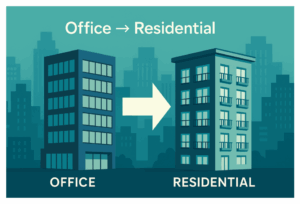Across the globe, office-to-residential conversions have exploded from a niche tactic into the decade’s defining real-estate play. Record downtown vacancy rates, generous tax carrots and an unrelenting urban housing crunch are propelling a planned 70,700 U.S. units for 2025—a three-year surge exceeding 200 percent. Investors who grasp this wave now can capture discounted assets, time savings and ESG kudos before the mainstream flood-gates open.
Why Office-to-Residential Conversions Are Booming
Vacancy & Value Freefall
Nationwide U.S. office vacancy spiked from 16.2 percent in Q4-2023 to 22 percent in Q1-2025. Asset prices for Class B/C towers have tumbled as much as 50 percent, turning once-prized CBD listings into affordable raw material for office-to-residential conversions.
Housing Shortage in Core Districts
Urban multifamily rents climbed 22 percent since 2020, yet permits lag demand. Converting obsolete office shells trims roughly 30 percent of cost and schedule versus new builds, easing supply faster and cheaper.
Policy Tailwinds
- Chicago set aside US$150 million to subsidise 1,000+ affordable units in ex-office towers.
- New York City offers a 90 percent tax abatement when at least 25 percent of the converted apartments are affordable.
- Hong Kong fast-tracks wholesale changes of industrial/office buildings and waives conversion fees through 2027.
2024-2025 Data Snapshot
Key 2025 Figures
- Total U.S. pipeline: 70,700 units (+28 percent YoY).
- Share of all adaptive-reuse projects: 42 percent—an all-time high.
- Suitable vacant office inventory: approx. 1.2 billion ft² (14.8 percent of stock).
Top Markets Table
| Metro | Pipeline Units | Share of Local Re-use |
|---|---|---|
| New York | 8,310 | 61 % |
| Washington, DC | 6,533 | 74 % |
| Los Angeles | 4,388 | 49 % |
| Chicago | 3,600 | 54 % |
| Dallas | 2,720 | 79 % |
| Atlanta | 2,239 | 56 % |
Figure 1: Bar-chart visualising these numbers is available in the downloadable asset package adjacent to this post.
Global Echoes of the Conversion Wave
Europe
Berlin alone could unlock 2,540 flats via office-to-residential conversions by 2025; yet permitting hurdles remain. The EU’s tightened Energy Performance Directive will effectively force deep retrofits on “F–G” buildings from 2030—another nudge toward conversions.
Canada
CMHC’s 2024 supply report earmarks 40 percent of rapid-housing funds for adaptive re-use, with federal towers in Ottawa and Calgary first in line.
Asia-Pacific
Facing a budget gap, Hong Kong suspended most land auctions and instead pushes wholesale re-use of existing commercial stock, waiving statutory charges to accelerate office-to-residential conversions.
12-Month Outlook (May 2025 → April 2026)
Demand & Supply Dynamics
A projected 75-basis-point Fed rate-cut cycle should revive construction lending, though lenders will still prefer well-located Class B/C shells. U.S. completions may double to ~15,000 apartments—still under a quarter of the current pipeline.
Pricing Trajectory
Completed conversions in New York City trade at a 5.1 percent cap, versus 4.0 percent for new luxury rentals. Expect 50-basis-point compression as leased-up projects rotate into core-plus funds.
Primary Risks
- Feasibility Gaps: Only ~20 percent of vacant towers meet light-depth and window-line requirements.
- Capital Stack Holes: Regional banks still digest CRE losses; mezzanine debt priced at SOFR + 8 % is filling the void.
- Regulatory Delays: The U.K.’s latest permitted-development reform slipped to 2026 at the earliest.
Actionable Recommendations for Investors
- Target “Goldilocks” Buildings—1980-2000 vintages, 12-18 m core depth and 3.7 m floor-to-floor heights make office-to-residential conversions straightforward.
- Stack Incentives—Combine city abatements with U.S. IRA §179D energy credits (up to US$5/ft²).
- Offer Preferred Equity—Bridge lenders want risk premiums; pref-equity at 12-14 percent plus warrants can unlock deals.
- Underwrite Fast Lease-Ups—Discount to Class-A rentals narrows sharply once projects hit 85 percent occupancy.
- Leverage ESG Marketing—Adaptive re-use slashes embodied carbon ~50 percent, appealing to SFDR and EU-Taxonomy-driven capital.
Conclusion Recap
Office-to-residential conversions are more than a cyclical play—they represent a structural shift in how cities allocate space. With 70 K U.S. units in the pipeline, policy support expanding worldwide and debt liquidity slowly thawing, the next 12 months offer a prime window for disciplined investors.
For deeper strategy dives and live project trackers, contact us.
FAQ
Office-to-Residential Conversion FAQ
What makes an office building ideal for conversion?
Slim core depth (≤ 23 m), abundant window lines and ≥ 3.5 m floor-to-floor heights. Buildings from 1980-2000 are often the easiest to retrofit.
How long does a typical office-to-residential conversion take?
Most projects require 18–24 months, versus 30–36 months for ground-up multifamily construction.
Are conversions profitable in high-vacancy markets?
Yes—lower acquisition prices plus incentives can push un-levered IRRs above 15 percent, provided rental demand exists.
Do conversions qualify for green tax credits?
In many jurisdictions they do. In the U.S., Section 179D and multiple state-level energy credits can offset HVAC and envelope upgrades.
References
- CBRE research, 2025.
- NAIOP adaptive-reuse report, 2023.
- RentCafe, “Record-breaking 71 K Apartments from Office Conversions,” Feb 2025.
- CMHC, Rapid Housing Funding Dashboard, 2024.
- EU Council, Energy Performance of Buildings Directive, 2024.




